The Interaction between Storm Surge and Concomitant Waves in Shandong Peninsula
Abstract
:1. Introduction
2. Coupled Wave–Current Model
2.1. Model Description
2.2. Model Configuration and Validation
2.3. Storm Events and Model Experiments
3. Results and Discussion
3.1. Distribution of Storm Surges and Waves
3.2. Impact of Waves on Storm Surge
3.3. Impact of Water Level Change on Wave Height
3.4. Impact of Current Field on Wave Height
4. Summary and Concluding Remarks
Author Contributions
Funding
Institutional Review Board Statement
Informed Consent Statement
Data Availability Statement
Conflicts of Interest
References
- Feng, S. Introduction to Storm Surge; Science Press: Beijing, China, 1982. (In Chinese) [Google Scholar]
- Li, J.; Nie, B. Storm surge prediction: Present status and future challenges. Procedia IUTAM 2017, 25, 3–9. [Google Scholar] [CrossRef]
- Needham, H.F.; Keim, B.D.; Sathiaraj, D. A review of tropical cyclone-generated storm surges: Global data sources, observations, and impacts. Rev. Geophys. 2015, 53, 545–591. [Google Scholar] [CrossRef]
- Dietrich, J.C.; Zijlema, M.; Westerink, J.J.; Holthuijsen, L.H.; Dawson, C.; Luettich, R.A., Jr.; Jensen, R.E.; Smith, J.M.; Stelling, G.S.; Stone, G.W. Modeling hurricane waves and storm surge using integrally-coupled, scalable computations. Coast. Eng. 2011, 58, 45–65. [Google Scholar] [CrossRef]
- Funakoshi, Y.; Hagen, S.C.; Bacopoulos, P. Coupling of Hydrodynamic and Wave Models: Case Study for Hurricane Floyd (1999) Hindcast. J. Waterw. Port Coast. Ocean. Eng. 2008, 134, 321–335. [Google Scholar] [CrossRef]
- Dietrich, J.C.; Bunya, S.; Westerink, J.J.; Ebersole, B.A.; Smith, J.M.; Atkinson, J.H.; Jensen, R.; Resio, D.T.; Luettich, R.A.; Dawson, C.; et al. A High-Resolution Coupled Riverine Flow, Tide, Wind, Wind Wave, and Storm Surge Model for Southern Louisiana and Mississippi. Part II: Synoptic Description and Analysis of Hurricanes Katrina and Rita. Mon. Weather Rev. 2010, 138, 378–404. [Google Scholar] [CrossRef]
- Kim, S.Y.; Yasuda, T.; Mase, H. Wave set-up in the storm surge along open coasts during Typhoon Anita. Coast. Eng. 2010, 57, 631–642. [Google Scholar] [CrossRef]
- Zhao, H.C.; Yin, B.S.; Feng, X.R.; Yang, D.Z. Numerical study of influence of surge and wave interaction on waves in Waters surrounding Taiwan. Mar. Sci. 2015, 39, 127–134, (In Chinese with English Abstract). [Google Scholar]
- Sun, Y.; Perrie, W.; Toulany, B. Simulation of Wave-Current Interactions Under Hurricane Conditions Using an Unstructured-Grid Model: Impacts on Ocean Waves. J. Geophys. Res. Ocean. 2018, 123, 3739–3760. [Google Scholar] [CrossRef]
- Wuxi, Q.; Li, J.; Nie, B. Effects of tide-surge interaction and wave set-up/set-down on surge: Case studies of tropical cyclones landing China’s Zhe-Min coast. Theor. Appl. Mech. Lett. 2018, 8, 153–159. [Google Scholar] [CrossRef]
- Xie, L.; Pietrafesa, L.J.; Wu, K. A numerical study of wave-current interaction through surface and bottom stresses: Coastal ocean response to Hurricane Fran of 1996. J. Geophys. Res. Ocean. 2003, 108, 3049. [Google Scholar] [CrossRef]
- Dietrich, J.C.; Tanaka, S.; Westerink, J.J.; Dawson, C.N.; Luettich, R.A., Jr.; Zijlema, M.; Holthuijsen, L.H.; Smith, J.M.; Westerink, L.G.; Westerink, H.J. Performance of the Unstructured-Mesh, SWAN+ADCIRC Model in Computing Hurricane Waves and Surge. J. Sci. Comput. 2011, 52, 468–497. [Google Scholar] [CrossRef]
- Xu, S.; Yin, K.; Huang, W.; Zheng, W. Numerical simulation of typhoon-induced storm surge on the coast of Jiangsu Province, China, based on coupled hydrodynamic and wave models. J. Southeast Univ. 2014, 30, 489–494. [Google Scholar] [CrossRef]
- Marsooli, R.; Lin, N. Numerical Modeling of Historical Storm Tides and Waves and Their Interactions Along the U.S. East and Gulf Coasts. J. Geophys. Res. Ocean. 2018, 123, 3844–3874. [Google Scholar] [CrossRef]
- Li, A.; Guan, S.; Mo, D.; Hou, Y.; Hong, X.; Liu, Z. Modeling wave effects on storm surge from different typhoon intensities and sizes in the South China Sea. Estuar. Coast. Shelf Sci. 2020, 235, 106551. [Google Scholar] [CrossRef]
- Ji, H.; Lan, Y.; Tu, Z.; Lin, Y.; Xiao, Z. Influence analysis of various parameters of SWAN model under extreme wind conditions. China Harb. Eng. 2021, 41, 1–5, (In Chinese with English Abstract). [Google Scholar]
- Li, W. Overview of historical storm surge disasters in the Shandong Peninsula and its northern coastal areas. Mar. Sci. 1991, 15, 24–26. (In Chinese) [Google Scholar]
- Yang, Y.; Cao, Y. Study on storm tide on Bohai coast, Peninsula of Shandong and Liaodong since 500 years BP. Yantai Teach. Coll. J. 1992, 8, 46–51, (In Chinese with English Abstract). [Google Scholar]
- Lin, Z.; Zhao, L. Typhoon surge disasters along the coast of Qingdao. Shandong Meteorol. 2000, 20, 19–21. (In Chinese) [Google Scholar]
- Chen, X.; Zhang, S.; Cui, Z.; Ding, J.; Qi, X.; Chen, J. Analysis of the “10.11” extratropical storm surge in Laizhou Bay. Mar. Forecast. 2004, 21, 88–92. (In Chinese) [Google Scholar]
- Gui, Q.; Sha, W. Numerical simulation of coupling wave-current in Huang-hai and Bo-hai Sea in spring. J. PLA Univ. Sci. Technol. 2005, 6, 71–75, (In Chinese with English Abstract). [Google Scholar]
- Lin, X.; Yin, B. Influence of interaction of waves in tide-surge on surface wind stress coefficient. J. Hohai Univ. 2007, 35, 714–717, (In Chinese with English Abstract). [Google Scholar]
- Xia, B.; Zhang, Q.; Jiang, C. A coupled wave-current numerical model on unstructured grids. Oceanol. Et Limnol. Sin. 2013, 44, 1451–1456, (In Chinese with English Abstract). [Google Scholar]
- Dalledonne, G.L.; Mayerle, R. Modelling of storm impacts on the Shandong Peninsula coast. J. Coast. Res. 2016, 74, 70–82. [Google Scholar] [CrossRef]
- Liu, Y.; Wang, X.; Wang, S. A numerical study of the influence of waves on storm surges. Trans. Oceanol. Limnol. 2007, S1, 1–7, (In Chinese with English Abstract). [Google Scholar]
- Fu, C.; Dong, J.; Wu, S.; Liu, Q. Numerical simulation on typical extratropical storm surge in the Bohai Sea. Mar. Forecast. 2011, 28, 1–8, (In Chinese with English Abstract). [Google Scholar]
- Feng, J.; Jiang, W.; Bian, C. Numerical prediction of storm surge in the Qingdao area under the impact of climate change. J. Ocean. Univ. China 2014, 13, 539–551. [Google Scholar] [CrossRef]
- Fan, S.; Chu, A.; Jiang, Q. Optimization of reanalysis wind field and its application in the simulation of extratropical storm surge in the Bohai Bay. Mar. Forecast. 2021, 38, 61–68, (In Chinese with English Abstract). [Google Scholar]
- Luettich, J.R.; Westerink, J.; Scheffner, N. ADCIRC: An Advanced Three-Dimensional Circulation Model for Shelves, Coasts, and Estuaries. Report 1; Theory and Methodology of ADCIRC-2DDI and ADCIRC-3DL.; DRP-92-6; US Army Corps of Engineers: Washington, DC, USA, 1992; p. 143.
- Irish, J.L.; Resio, D.T.; Ratcliff, J.J. The influence of storm size on hurricane surge. J. Phys. Oceanogr. 2008, 38, 2003–2013. [Google Scholar] [CrossRef]
- Fritz, H.M.; Blount, C.D.; Albusaidi, F.B.; Al-Harthy, A.H.M. Cyclone Gonu storm surge in Oman. Estuar. Coast. Shelf Sci. 2010, 86, 102–106. [Google Scholar] [CrossRef]
- Feng, X.; Yin, B.; Yang, D. Development of an unstructured-grid wave-current coupled model and its application. Ocean. Model. 2016, 104, 213–225. [Google Scholar] [CrossRef]
- Feng, X.; Yin, B.; Yang, D.; Perrie, W. The effect of wave-induced radiation stress on storm surge during Typhoon Saomai (2006). Acta Oceanol. Sin. 2011, 30, 20–26. [Google Scholar] [CrossRef]
- Holthuijsen, L.H.; Powell, M.D.; Pietrzak, J.D. Wind and waves in extreme hurricanes. J. Geophys. Res. Ocean. 2012, 117, C09003. [Google Scholar] [CrossRef]
- Wang, N.; Hou, Y.; Mo, D.; Li, J. Hazard assessment of storm surges and concomitant waves in Shandong Peninsula based on long-term numerical simulations. Ocean. Coast. Manag. 2021, 213, 105888. [Google Scholar] [CrossRef]
- Mo, D.; Hou, Y.; Li, J.; Liu, Y. Study on the storm surges induced by cold waves in the Northern East China Sea. J. Mar. Syst. 2016, 160, 26–39. [Google Scholar] [CrossRef]
- Chen, Y.; Yu, X. Sensitivity of storm wave modeling to wind stress evaluation methods. J. Adv. Model. Earth Syst. 2017, 9, 893–907. [Google Scholar] [CrossRef]
- Mcinnes, K.L.; Walsh, K.J.E.; Hubbert, G.D.; Beer, T. Impact of sea-level rise and storm surges on a coastal community. Nat. Hazards 2003, 30, 187–207. [Google Scholar] [CrossRef]
- Weisberg, R.H.; Zheng, L. Hurricane storm surge simulations comparing three-dimensional with two-dimensional formulations based on an Ivan-like storm over the Tampa Bay, Florida region. J. Geophys. Res. Ocean. 2008, 113, C12001. [Google Scholar] [CrossRef]
- Feng, X.; Yin, B.; Yang, D. Effect of hurricane paths on storm surge response at Tianjin, China. Estuar. Coast. Shelf Sci. 2012, 106, 58–68. [Google Scholar] [CrossRef]
- Huang, Y.; Weisberg, R.H.; Zheng, L.; Zijlema, M. Gulf of Mexico hurricane wave simulations using SWAN: Bulk formula-based drag coefficient sensitivity for Hurricane Ike. J. Geophys. Res. Ocean. 2013, 118, 3916–3938. [Google Scholar] [CrossRef]
- Fan, Y.; Ginis, I.; Hara, T.; Wright, C.W.; Walsh, E.J. Numerical simulations and observations of surface wave fields under an extreme tropical cyclone. J. Phys. Oceanogr. 2009, 39, 2097–2116. [Google Scholar] [CrossRef]
- Wang, P.; Sheng, J. A comparative study of wave-current interactions over the eastern Canadian shelf under severe weather conditions using a coupled wave-circulation model. J. Geophys. Res. Ocean. 2016, 121, 5252–5281. [Google Scholar] [CrossRef]
- Ardhuin, F.; Rascle, N.; Belibassakis, K.A. Explicit wave-averaged primitive equations using a generalized Lagrangian mean. Ocean. Model. 2008, 20, 35–60. [Google Scholar] [CrossRef]
- Wolf, J.; Prandle, D. Some observations of wave-current interaction. Coast. Eng. 1999, 37, 471–485. [Google Scholar] [CrossRef]

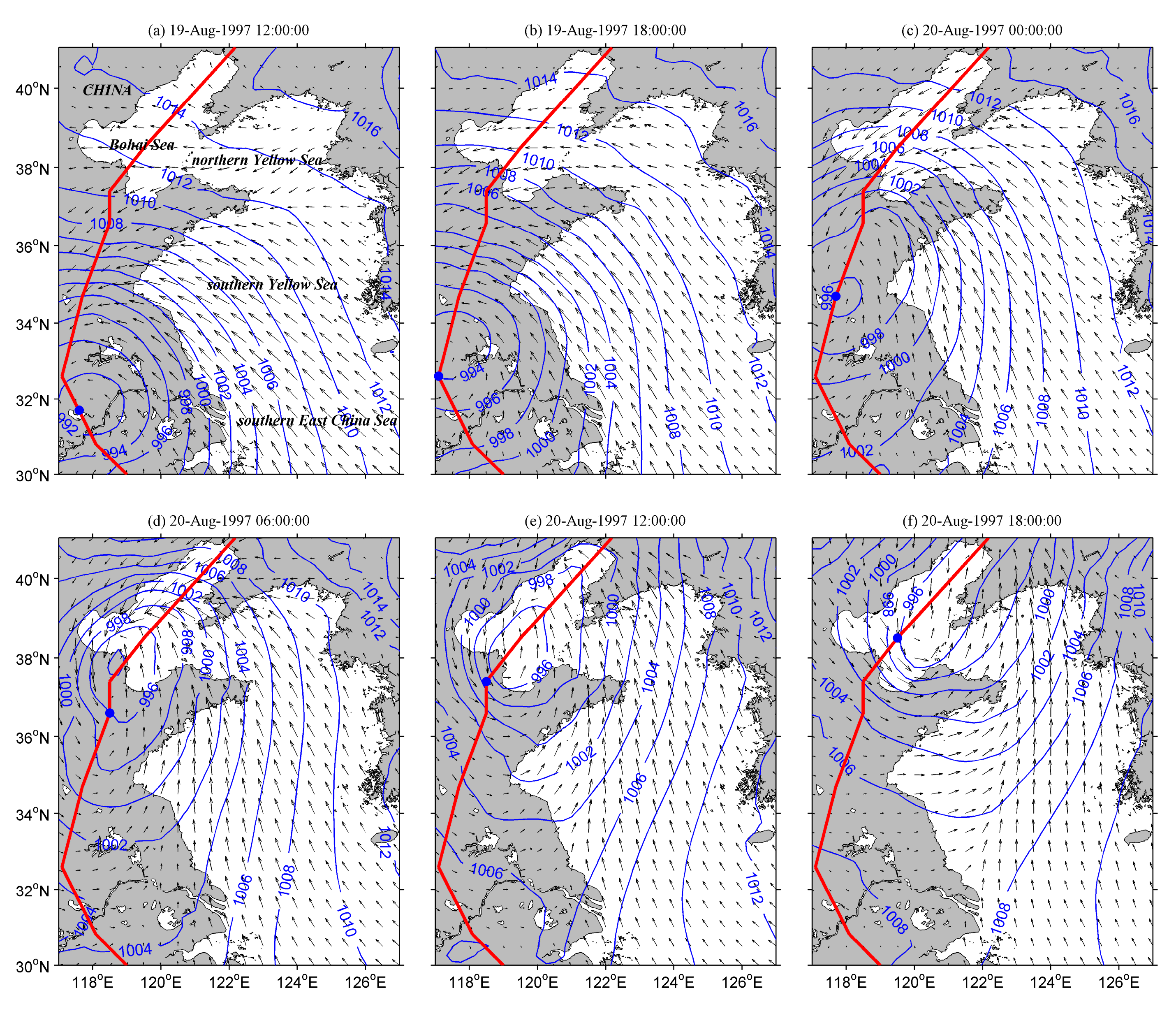
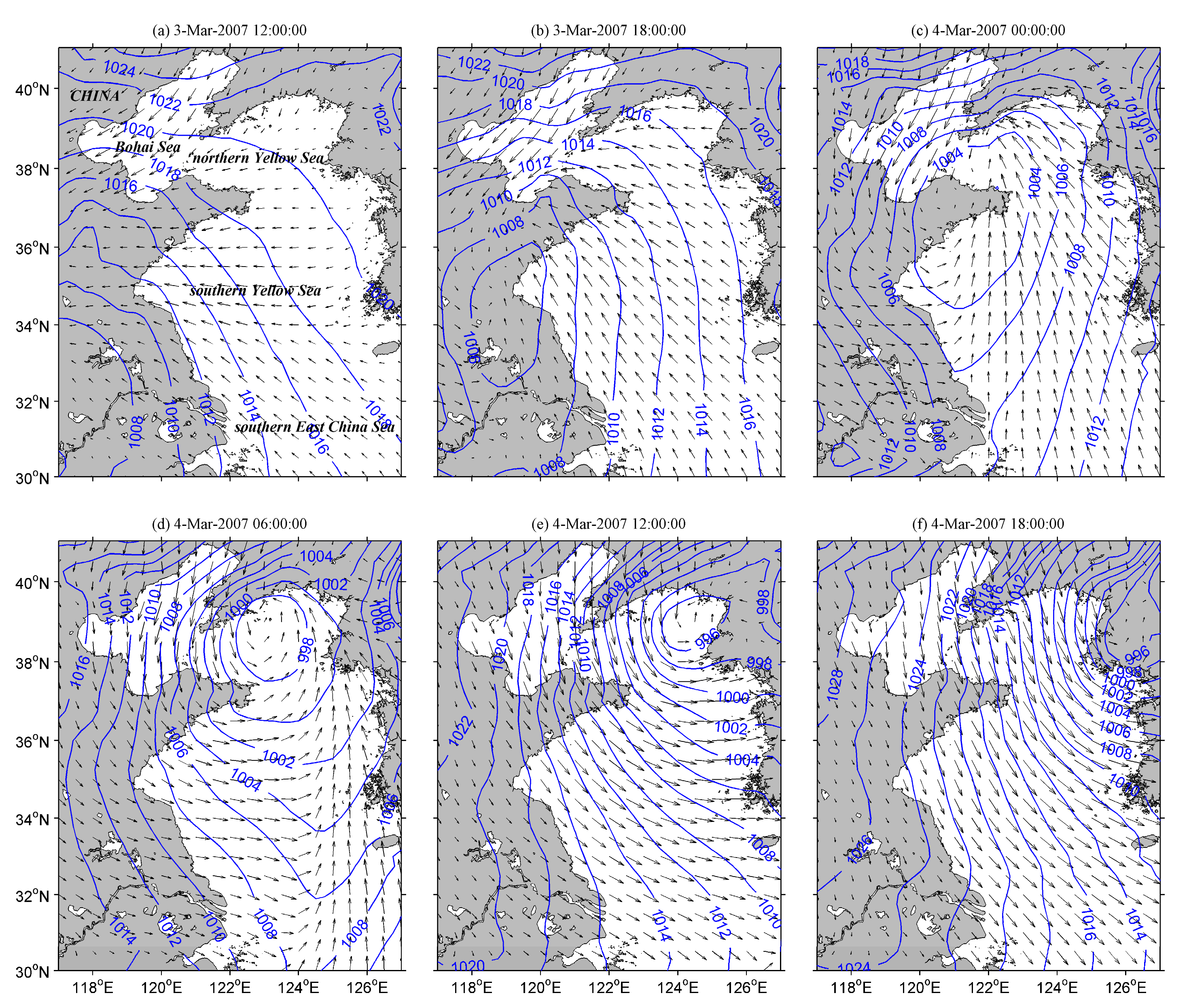
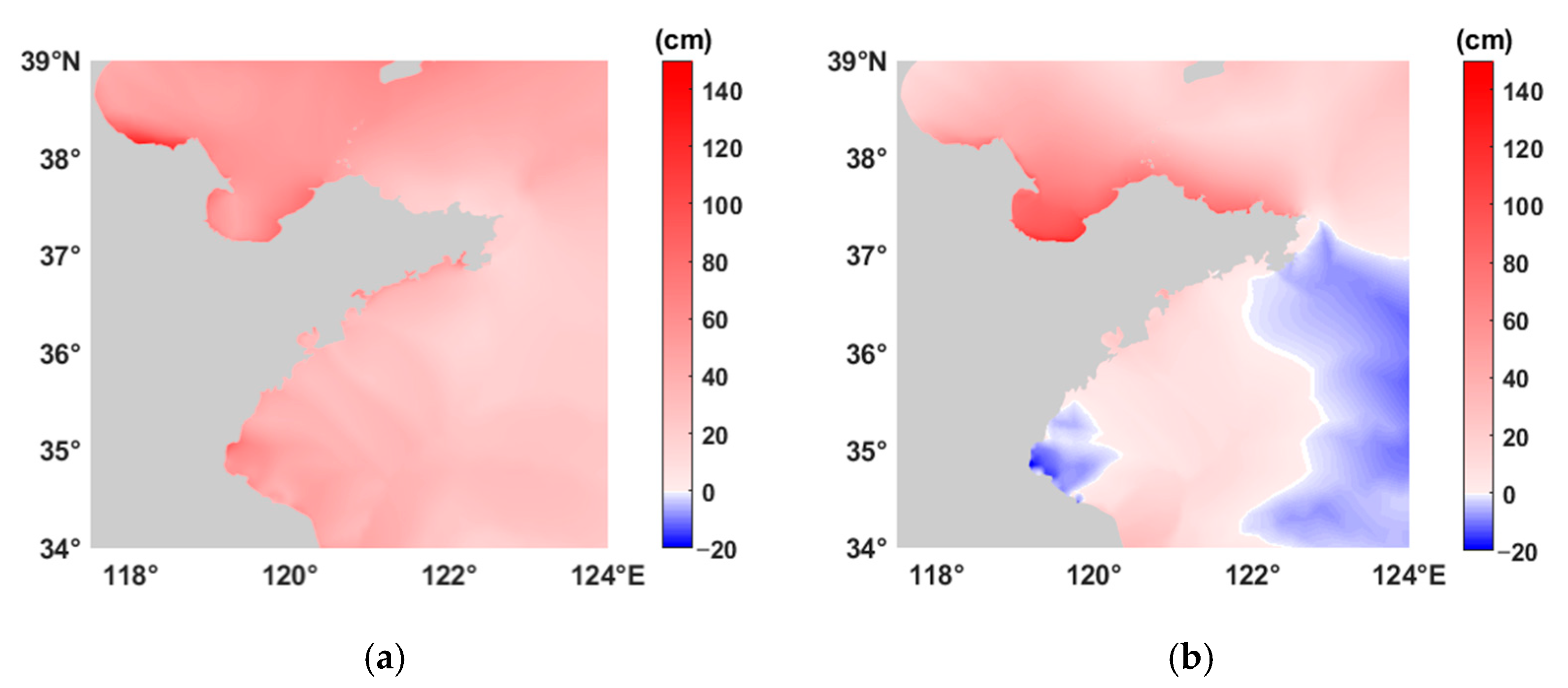
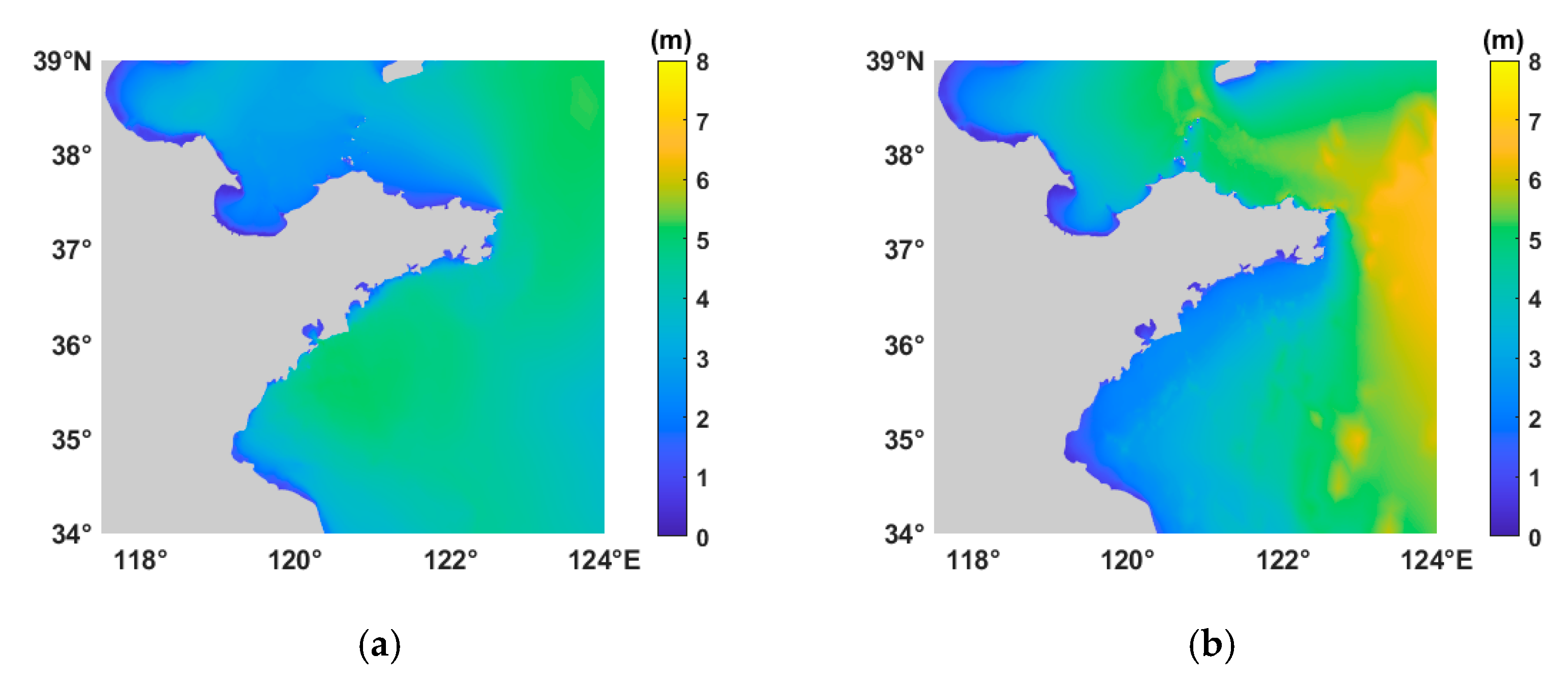
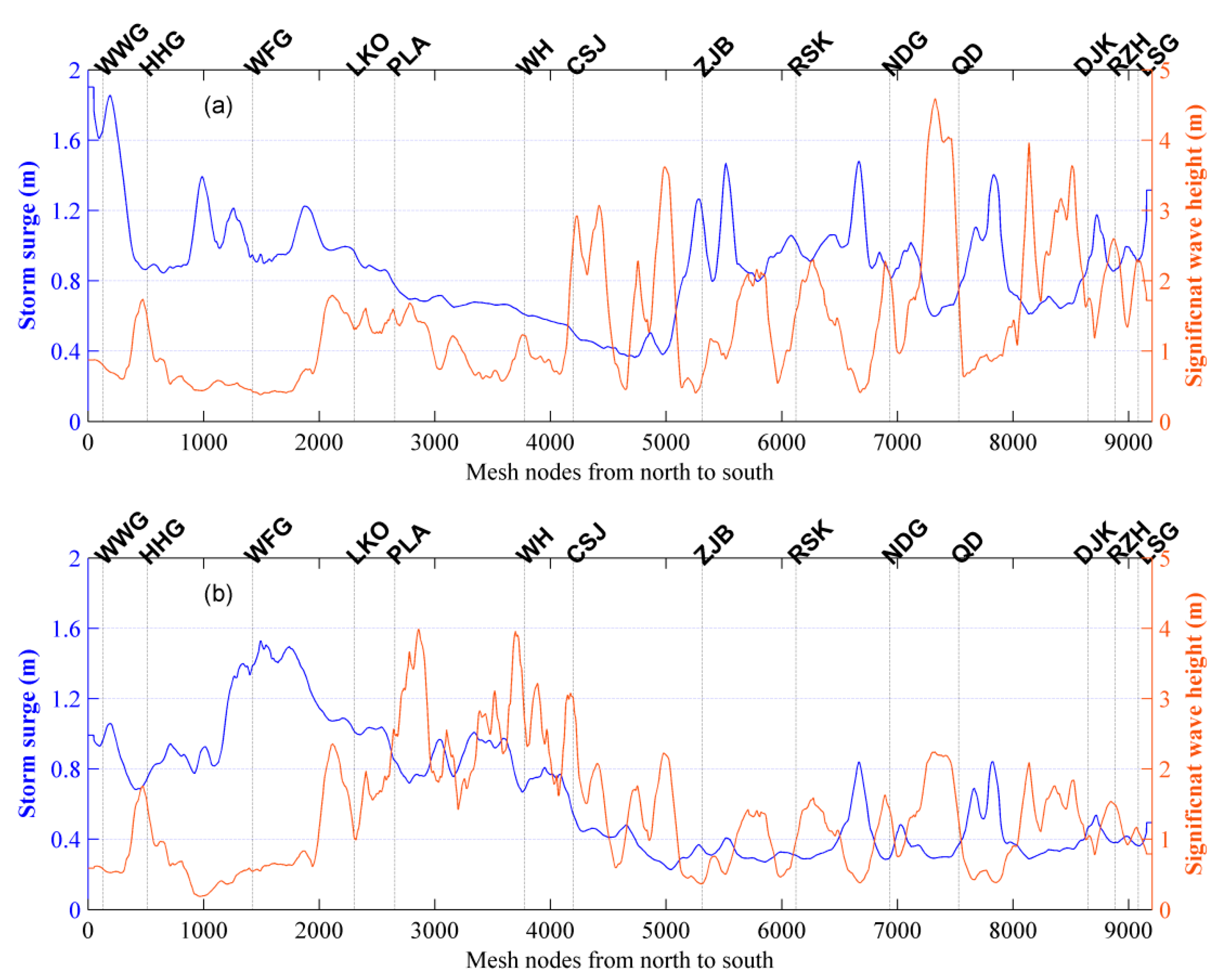
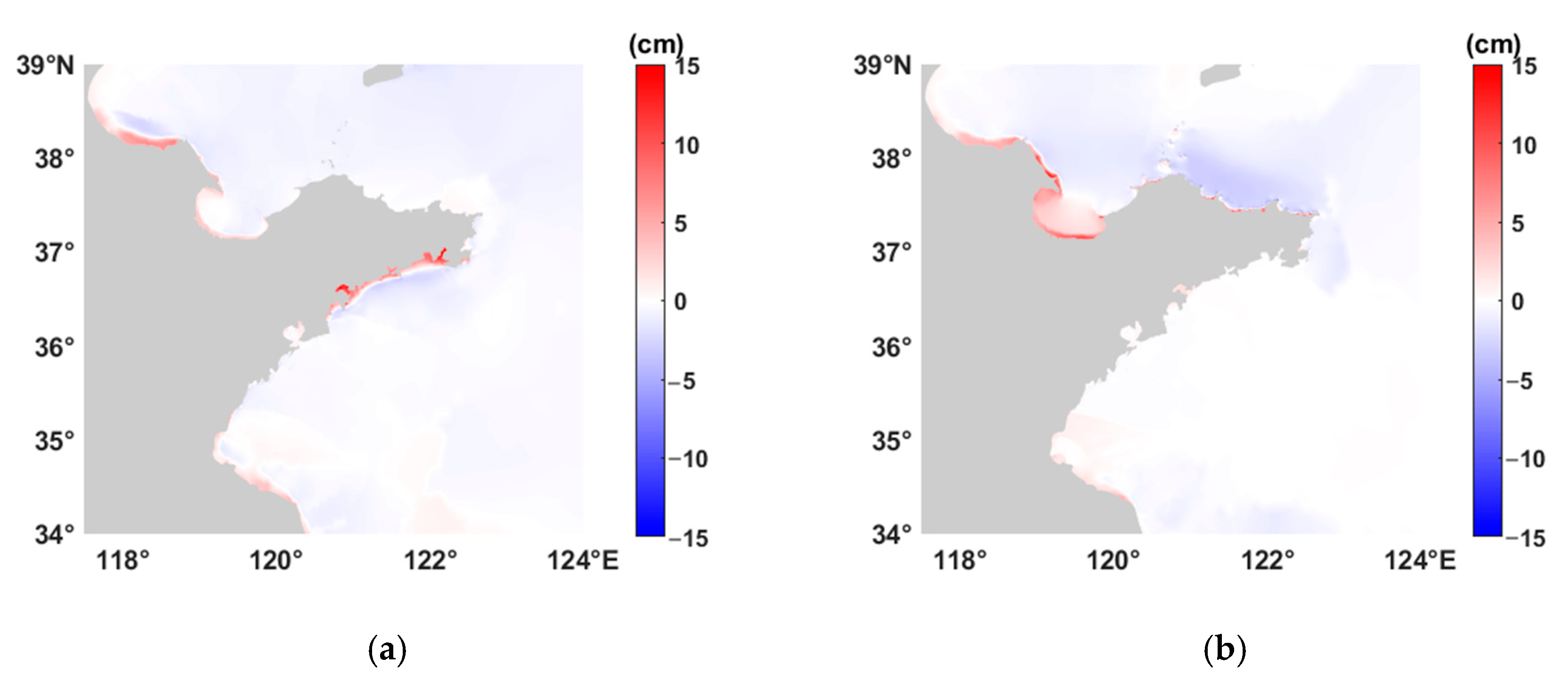
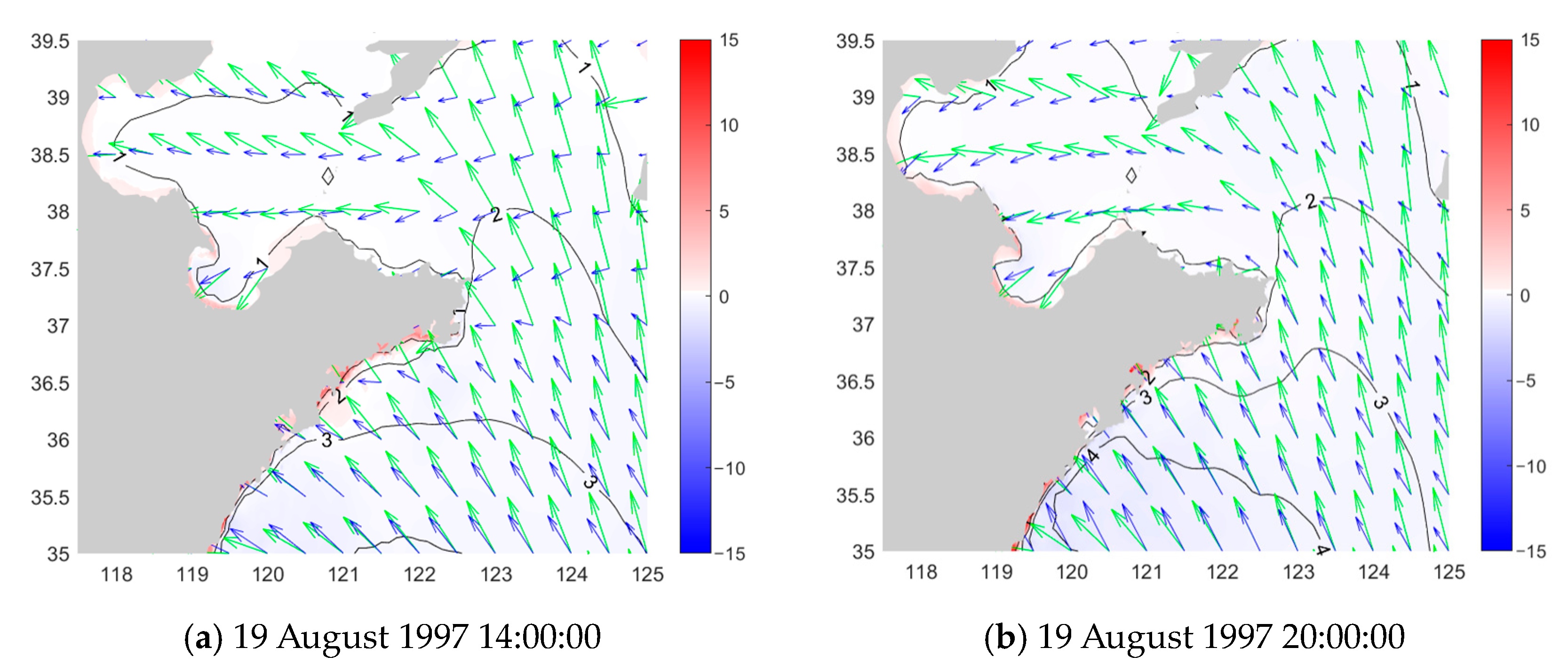

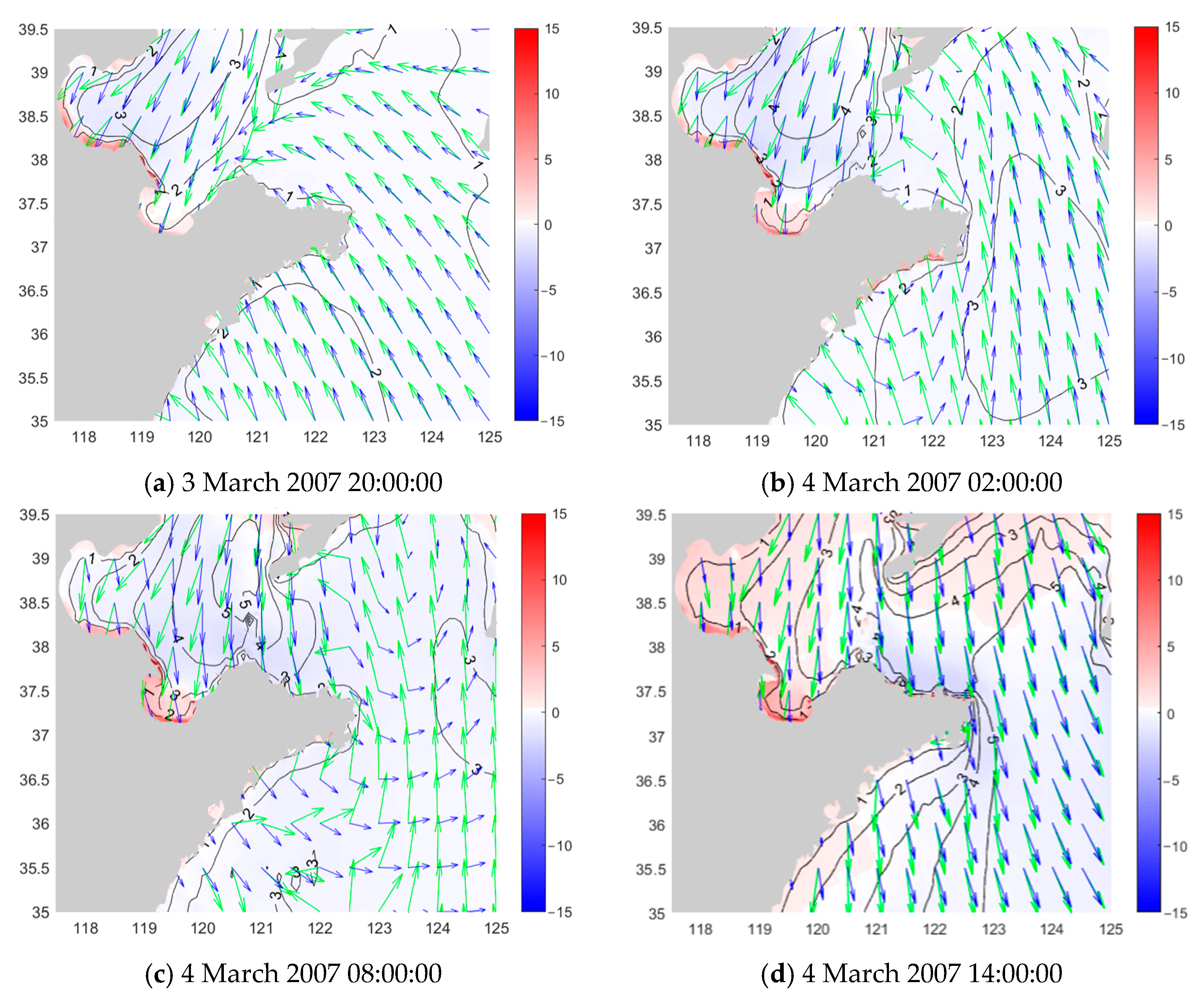

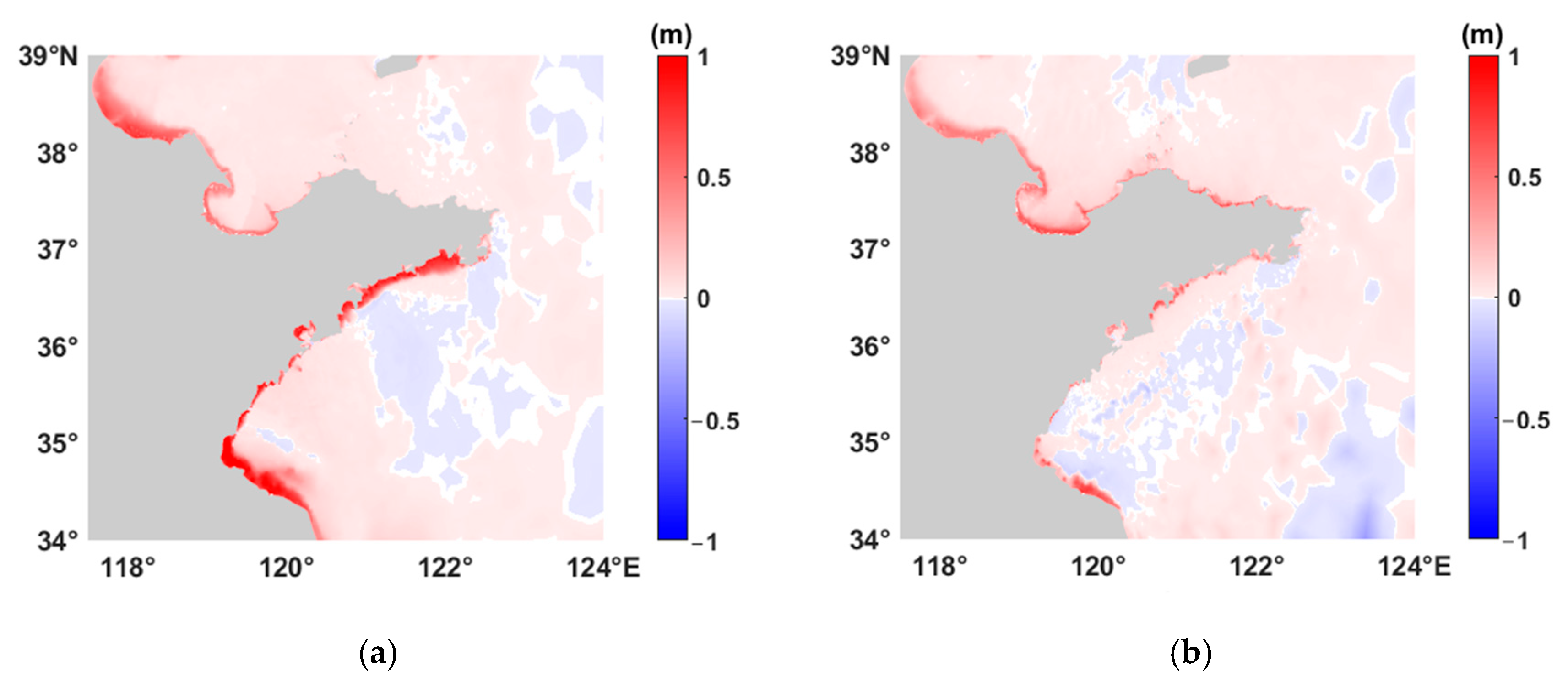
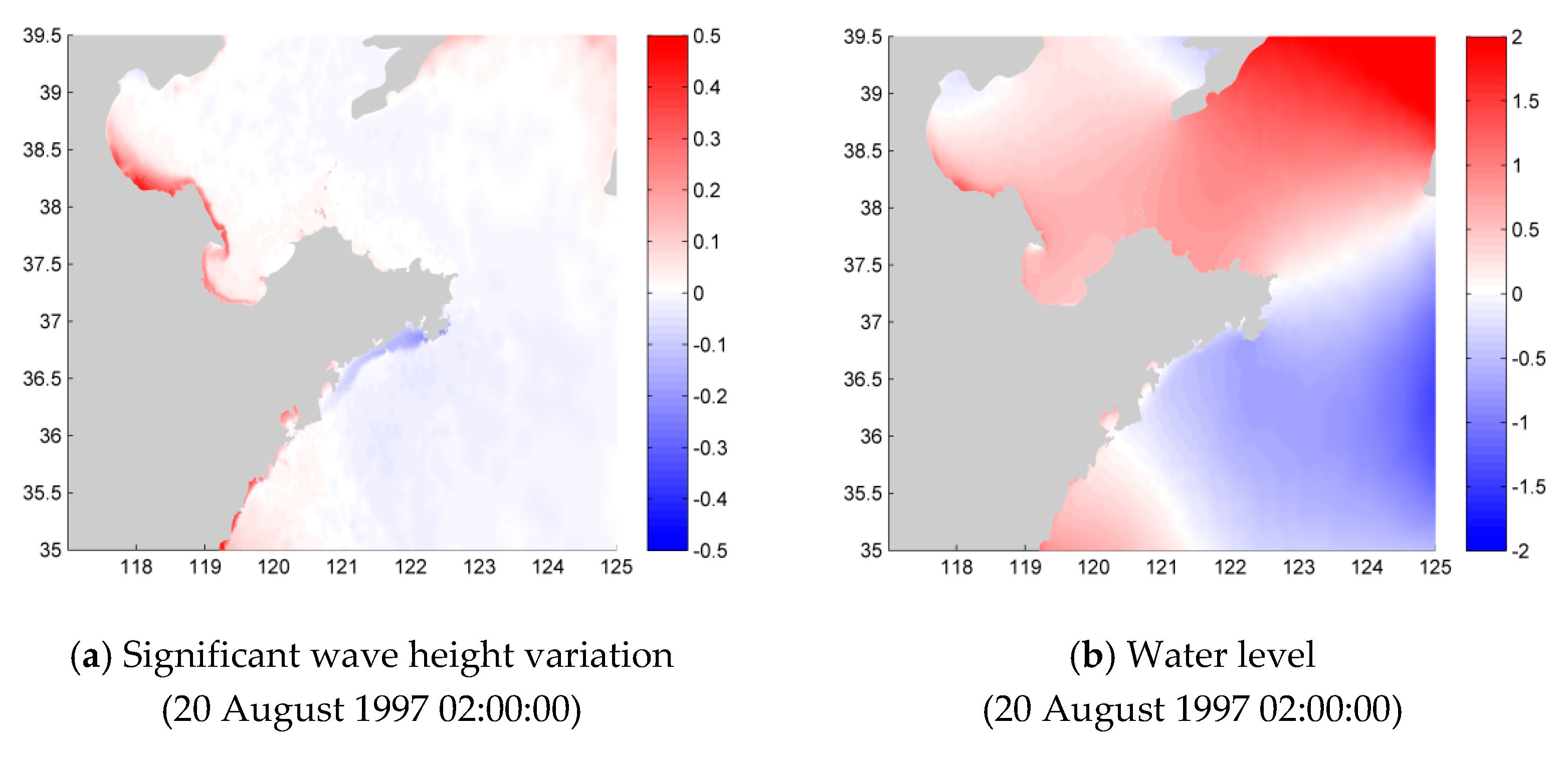
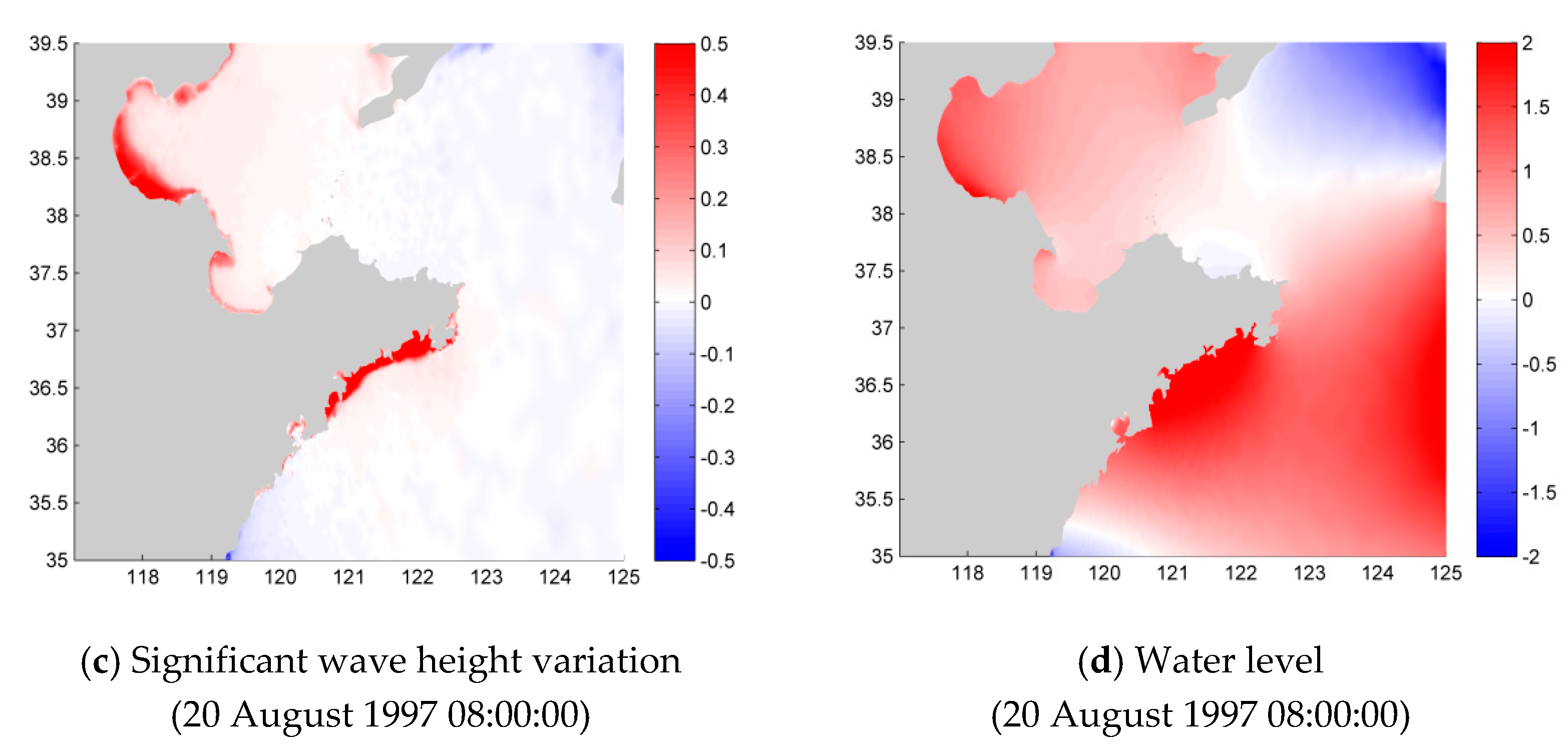

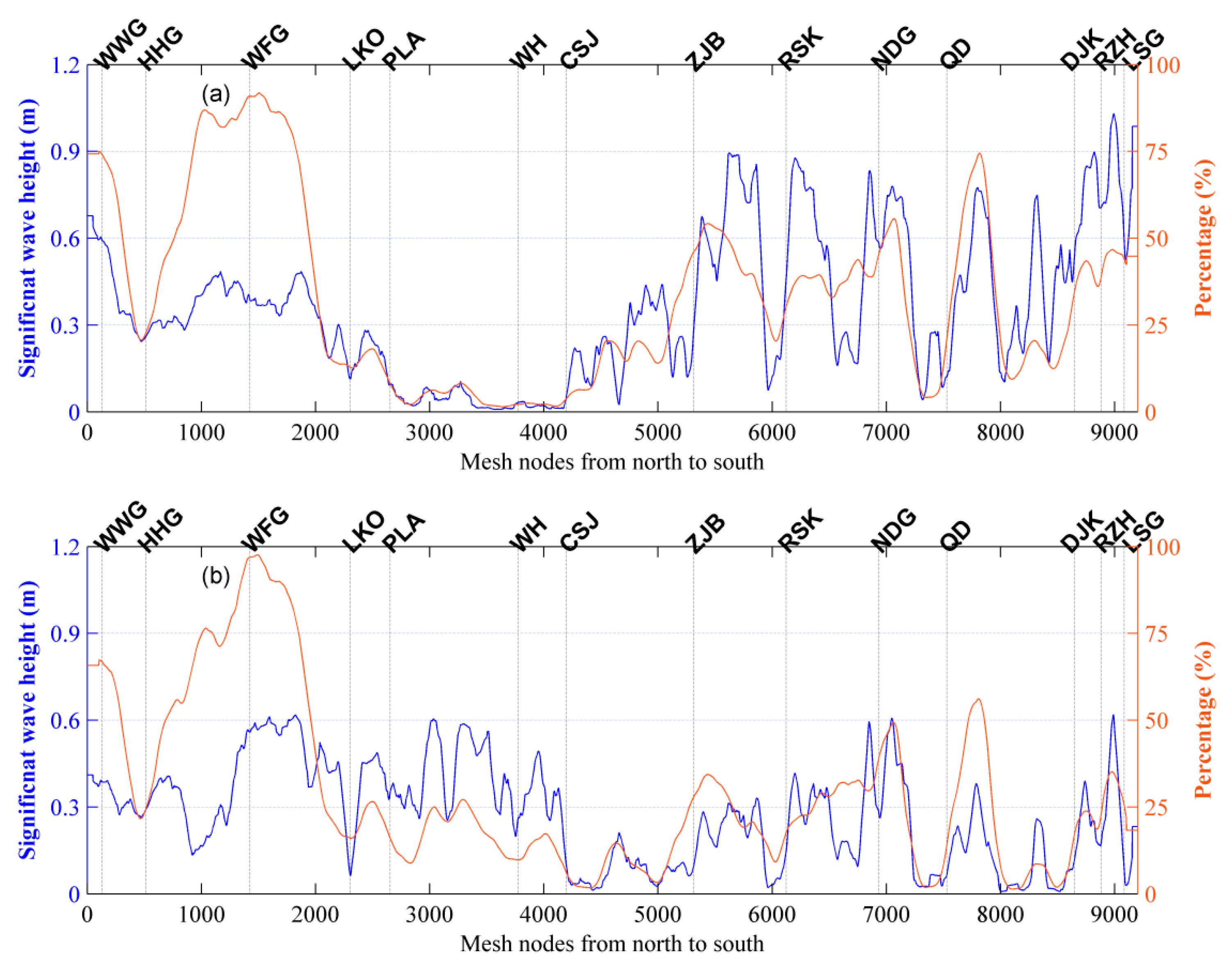

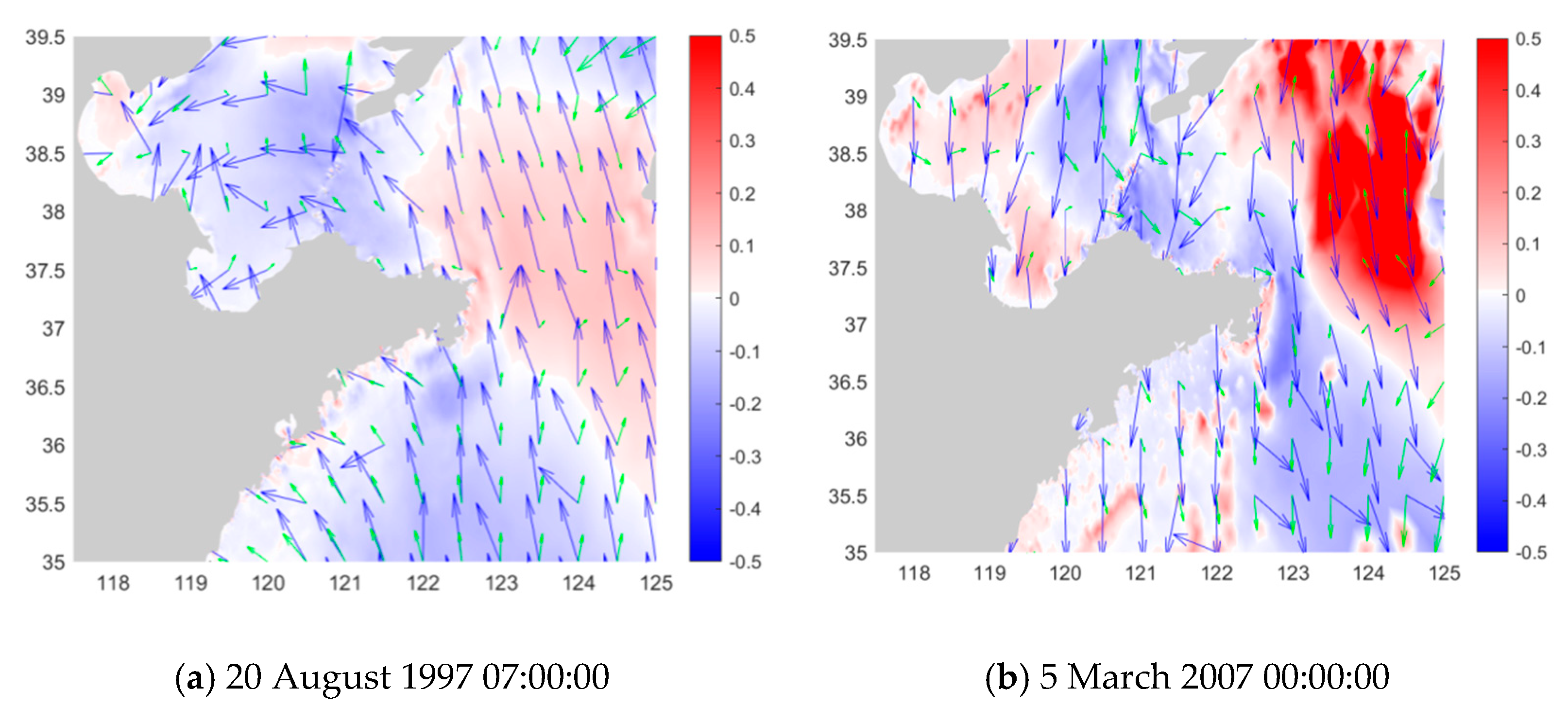
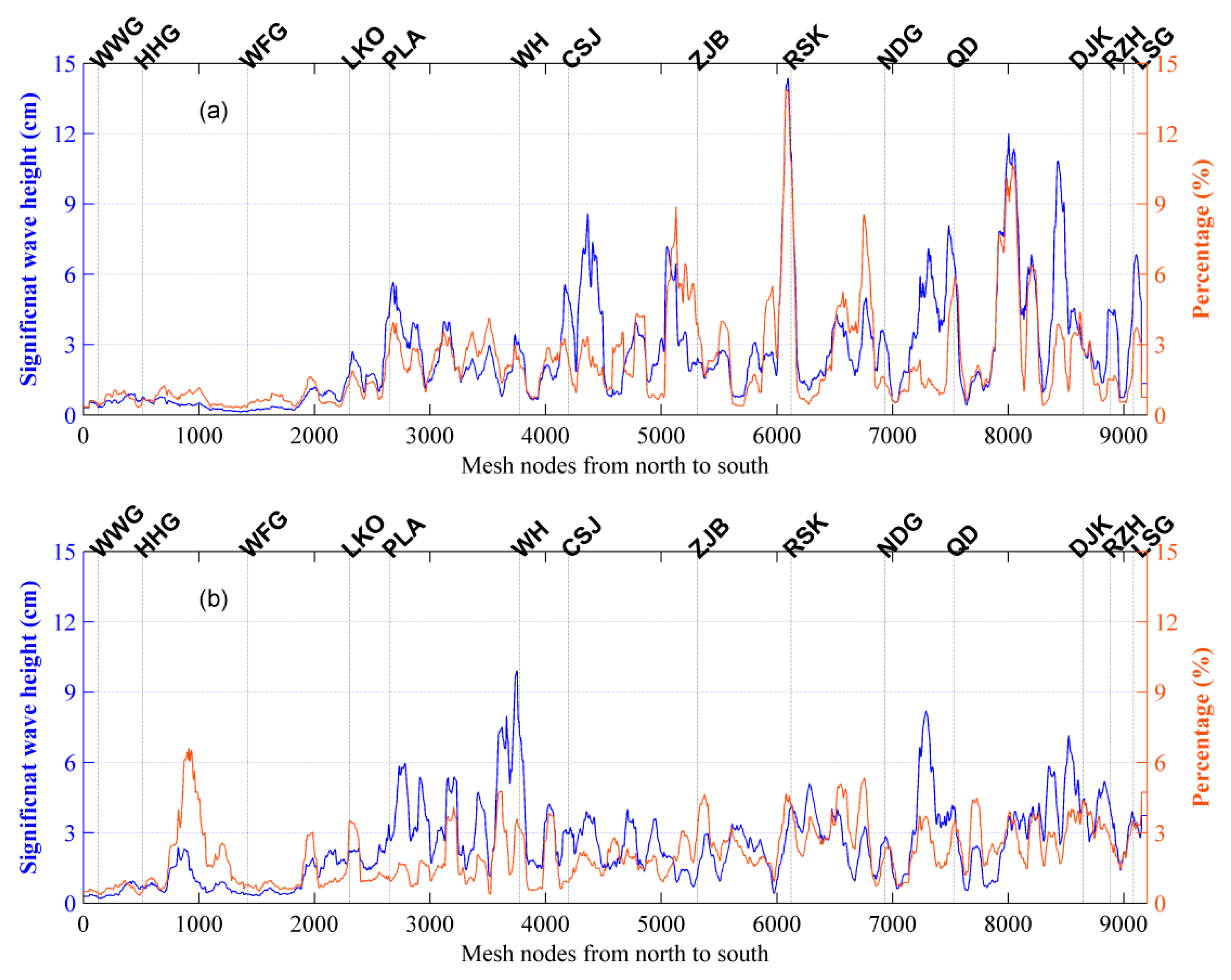
| EXP | Model | Tide | Wind and Pressure | Water Level | Current |
|---|---|---|---|---|---|
| EXP1 | ADCIRC | √ | × | - | - |
| EXP2 | ADCIRC | √ | √ | - | - |
| EXP3 | ADCIRC-SWAN | √ | √ | √ | √ |
| EXP4 | ADCIRC-SWAN | √ | √ | × | √ |
| EXP5 | ADCIRC-SWAN | √ | √ | √ | × |
Disclaimer/Publisher’s Note: The statements, opinions and data contained in all publications are solely those of the individual author(s) and contributor(s) and not of MDPI and/or the editor(s). MDPI and/or the editor(s) disclaim responsibility for any injury to people or property resulting from any ideas, methods, instructions or products referred to in the content. |
© 2023 by the authors. Licensee MDPI, Basel, Switzerland. This article is an open access article distributed under the terms and conditions of the Creative Commons Attribution (CC BY) license (https://creativecommons.org/licenses/by/4.0/).
Share and Cite
Mo, D.; Wang, N.; Hu, P.; Hou, Y. The Interaction between Storm Surge and Concomitant Waves in Shandong Peninsula. J. Mar. Sci. Eng. 2023, 11, 1759. https://doi.org/10.3390/jmse11091759
Mo D, Wang N, Hu P, Hou Y. The Interaction between Storm Surge and Concomitant Waves in Shandong Peninsula. Journal of Marine Science and Engineering. 2023; 11(9):1759. https://doi.org/10.3390/jmse11091759
Chicago/Turabian StyleMo, Dongxue, Ning Wang, Po Hu, and Yijun Hou. 2023. "The Interaction between Storm Surge and Concomitant Waves in Shandong Peninsula" Journal of Marine Science and Engineering 11, no. 9: 1759. https://doi.org/10.3390/jmse11091759




